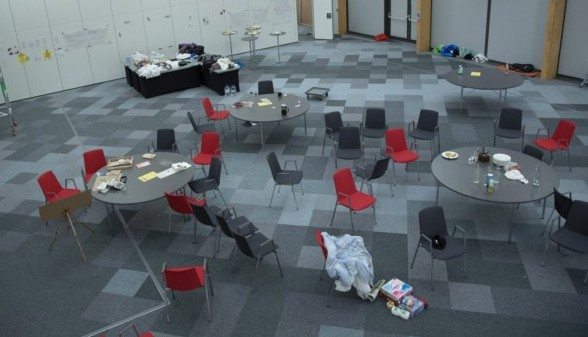Inside the occupation
In the wake of demonstrations that took place in November and December 2010, a response to dramatic increases in University tuition fees, we were bombarded with images of student activism that represented violence, vandalism and a volatile student-management relationship. This resulted in a rhetoric that students were merely rioting without just cause, suggesting that a group mentality, rather than a burning desire for change fuelled the fire. For those external to the situation, it is easy to forget that this depiction of the minute minority of the student population is vastly disparate from the reality of student protest.
Similarly, when the occupation of the Slate building on Warwick campus occupation began last month, the announcement was greeted with eye rolls from many, as well as jokes about how many shipments of quinoa there would be delivered to the Slate and disgruntled muttering about the social liberation of that “lot” being “at it again.”
The depiction of the minute minority of the student population is vastly disparate from the reality of student protest
Passing judgement from the outside is easy, but once you meet the people in the occupation, it is even easier to see that these are not students who are looking for any excuse to create a scene. Instead, we found compassionate people standing up for the rights of others in the Warwick community. This is a group of people, albeit a small one, setting aside their health, education and comfort to fight against what they view as unjust: the meagre wage of hourly-paid teachers, the potential consequences of the Teaching Excellence Framework, and the injunction against occupation-style protest on campus.
My journey began at the Koan. There were around 100 of us, marching together in the freezing December night in solidarity with those at the heart of the demonstration. The sense of unity was only slightly marred by the constant presence of university security, and the knowledge that this occupation can be traced back to a similar demonstration involving security forces only two years prior.
As we approached the occupation, I was blinded by the grandeur of the Slate building. It is state of the art, shiny; it is also not for us. The outrage is easy to understand. Collectively, students pour millions of pounds into this University every year, yet are faced with issues such as a lack of study space, poor quality accommodation and left only with questions as to where their fees are actually going. The Slate building itself is a representation of some of the issues of the Higher Education Bill, such as the marketization of higher education and the capitalist university. Inside, a stronghold for change was built from handmade banners, hummus and heart.
Inside, a stronghold for change was built from handmade banners, hummus and heart.
What was perhaps the most striking about the journey into the occupation was the warmth of it; although not physical, as those in the occupation requested more bedding for their makeshift beds, fabrications of scaffolding and any blankets available. There is, however, an undeniable atmosphere of tolerance and acceptance. Looking around the room, I saw people of different colours, ages and backgrounds; some veterans of the movement, some embarking on their first steps into the world of student activism.
As people shared their stories from their time as activists, some recounted the events of December 3 2014, when police reportedly used excessive force against students occupying Senate House, with pain in their eyes. There were many notes of thanks for support of the occupation, for the organisation of the events in the Slate that week and most importantly, for each other.
Humbly, the occupiers asked for donations. At this point, it seemed as if the protest could last over the Christmas break. I am glad, as I’m sure they are too, that this was not the case. It was bitterly cold and bleak, something the occupiers had tried to tackle by hanging their banners on the sparse, clinically white walls. As I left, I was told to come back any time I liked, something I would encourage others to consider as we look towards a new year in student activism. At our University, this could be the frontline of change.

Comments